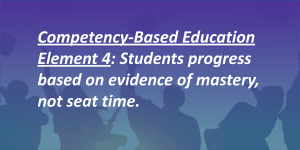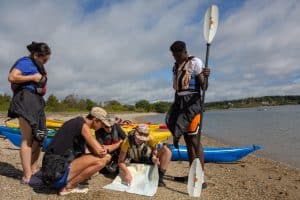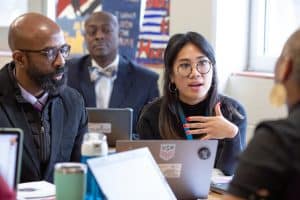CBE Starter Pack 4: Progress Based on Mastery
CompetencyWorks Blog
When educators begin to explore competency-based education (CBE), the CompetencyWorks Initiative is a key place to start, but it can be overwhelming to take it all in. This post is the fourth of a series of “CBE Starter Packs” focused on each of the seven elements of the Aurora Institute’s 2019 CBE Definition. A note on language: we use the different terms used in the field (e.g., competency, mastery, proficiency) interchangeably.
 At the heart of competency-based systems, decisions about student learning and advancement are made based on their demonstrated mastery – rather than their age or a standardized time frame. The first three elements of the CBE definition create the transparency, evidence, and learning skills and mindsets to enable student advancement based on mastery.
At the heart of competency-based systems, decisions about student learning and advancement are made based on their demonstrated mastery – rather than their age or a standardized time frame. The first three elements of the CBE definition create the transparency, evidence, and learning skills and mindsets to enable student advancement based on mastery.
- CBE Principle 1: Student Agency supports students in developing the agency, including executive functioning and metacognitive skills, that help them grown in their ownership of their learning.
- CBE Principle 2: Meaningful Assessment creates meaningful assessment opportunities that both support the learning process (assessment for learning) and generate evidence of learning. This allows both students and teachers to know where students are at to inform what they will learn next.
- CBE Principle 3: Timely, Differentiated Support guides learners in determining how they will learn and helps to ensure that every learner has the support they need to be making progress in their learning journey

Summative assessment, rather than occurring only at the end of a unit of learning and being fixed based on pacing guidelines for covering grade-level standards, is a flexible process that occurs when the teacher and student are reasonably confident the student is proficient. This might mean that summative assessments are organized based on when students are ready or that summative decisions are based on a body of evidence of learning in a portfolio. Students may advance more quickly in some academic domains, while taking more time in those that are more challenging.
In CBE systems, teachers strive to be transparent and consistent when assessing students’ proficiency. Doing so interrupts inequities of the traditional system that allow students to progress without fully mastering content and skills. To build consistency, educators score student work together and collaborate to develop rubrics with student work samples that illustrate what proficiency looks like. This reduces variability across teachers in expectations and judgments of proficiency. Shared high expectations are central to ensuring equity in a system where student progress is based on demonstrating mastery.
What does progress based on mastery look like?
These examples illustrate how real schools base student progress on their demonstrated mastery in practice, in ways that fit their own local communities. Implementing CBE is not one-size-fits all for students or for schools.
Example: Red Bank Elementary School
At Red Bank Elementary School (RBE) in the Lexington School District One in South Carolina, work to transform to a personalized, competency-based model began with optional summer retreats where staff learned together to understand what is wrong with the traditional system. Over 10 years later, all students at RBE are learning in an environment that develops the skills they need to be the drivers of their own learning. In their own words, RBE students  “know what standards must be learned and they are expected to show proficiency in learning those standards. Students progress at different rates and in different ways. They have choices about how they practice and demonstrate their acquisition of skills. Each student is challenged at his or her academic level.”
“know what standards must be learned and they are expected to show proficiency in learning those standards. Students progress at different rates and in different ways. They have choices about how they practice and demonstrate their acquisition of skills. Each student is challenged at his or her academic level.”
RBE staff focus on pedagogy and transparency — around students’ learning targets, their progress, and the different ways they can learn. They aim to teach students starting where they are in their own development, rather than focus on teaching a grade-based curriculum. RBE staff utilize technology and online learning tools to provide more options for learning, but keep their focus on meeting every student’s learning needs.
Learn more: The CompetencyWorks blog series on Red Bank Elementary includes five posts, Five big takeaways, Teaching students instead of standards, Teacher perspectives, Student perspectives, and Parent perspectives. RBE practitioners have also written for CompetencyWorks, such as this post Two Teachers’ Perspectives on CBE. Here is an interview with two RBE administrators (p. 12-16).
Alta Vista Innovation High School

At Alta Vista Innovation High School in Inglewood, CA, all curriculum is mastery-based and all students have personalized learning plans. Alta Vista serves many students who started in traditional high school settings but didn’t thrive there for various reasons. The school is part of the Learn4Life network of charter schools with 100 learning centers serving more than 49,000 students.
Every student has a “supervising teacher” who serves as their mentor and guide while also providing some academic support in their areas of certification. Most students take two subjects at a time, or three if they’re highly motivated. They work at their own pace through written and online materials, often in two-hour, small-group meetings with teachers and students, as well as with one-to-one support from teachers and tutors. Scheduling and pacing are flexible. Students come to school at least twice per week for four hours per day, but they can come as much beyond that as they want, so long as they’re being productive — which can mean not only making academic progress, but also meeting with a social worker or just coming in to eat lunch and connect with the school community.
Learn more: The CompetencyWorks blog has two posts about Alta Vista, Ensuring Responsiveness to Student Needs at Learn4Life Schools and Educating the Whole Child (and Young Adult) at Alta Vista Innovation High School. See also the student stories across the Learn4Life network and this video about Learn4Life in California.
What to Look for in the Student Experience

Can you see these student experience “look fors” in the examples above?
- Students know where they are in terms of performance levels on a learner continua and are able to work on learning objectives below or above grade level.
- Students have access to just-in-time assessments and have multiple opportunities to demonstrate proficiency.
- With transparency in the learning cycle and grading, students get feedback on their progress and growth with consistency and reliability. Students see examples of proficiency work in classrooms or in other resources, such as in a learning management system (LMS).
- Students learn the building blocks of learning and habits of work, as well as motivational strategies that encourage them to put forward their best effort in pursuit of mastery.
What school policies and practices support progress based on mastery? 
- Teachers engage in calibration (also called moderation or joint scoring) of student work to ensure inter-rater reliability.
- Teachers collaborate to strengthen teacher-generated performance assessments with task validation protocols.
- Districts and schools have mechanisms in place for quality assurance to ensure that variation is not creating a situation of lower expectations for some students or students advancing without the opportunity to fully master learning goals.
- Professional learning communities support clear expectations for teachers to address gaps in skills, so that students are not advancing with accumulated gaps in knowledge and skills. Leaders of instruction have up-to-date information about student progress, and regular conversations with their teachers (as a group and individually) about optimizing progress.
- School instructional models, schedules, and spaces meet students where they are using multiple instructional strategies, selected depending on where students are in their learning, the presence and size of their skills gap, the needs of other students in the class, and the knowledge and skills of the teacher.
Learn More
Dig into the research and background information
- Meetings Students Where They Are provides an in-depth exploration of the relational, pedagogical, and structural dimensions of meeting students where they are in K-12 CBE systems. These practices are the pedagogical foundation for enabling student progress based on mastery.
- What’s Possible with Personalized Learning? An Overview of Personalized Learning for Schools, Families & Communities is an Aurora report that provides examples of teachers personalizing learning in their schools and districts – including students moving on when they are ready.
Explore Examples and Resources
- A sampling of CompetencyWorks blog posts about basing student progress on mastery include: Flexible Pacing: Running The Same Race (elementary); Waukesha STEM Academy (WSA): Rethinking Space, Time, and Reporting and WSA’s Journey from ABC to the Learner Continuum (middle grades); and Rethinking the Master Schedule and Transparently Tracking and Communicating Progress and Growth in Competency-Based Schools from a series about Building 21 (high school).

- Create the systems and structures for students to progress based on mastery by rethinking schedules and the use of time. Scheduling for Personalized Competency-Based Education is a book by Doug Finn and Michelle Finn, who also presented a breakout session on the topic at #Aurora20. Diana Lebeaux’s post, Flexible School Schedules, includes an infographic illustrating daily schedules along a continuum of flexibility.

- Graduation Must Depend on Learning, Not Time: The overdue case for competency-based education is an EdWeek Opinion piece, written by six large district superintendents, about designing around mastery rather than time.
- Let’s Teach for Mastery—Not Test Scores is a TED Talk by Sal Khan where he makes the case for a new approach to learning based on mastery.
- The CBE Design Principle 4 Rubric is a resource from the book, Unpacking the Competency-Based Classroom, in which Vander Els and Stack offer a roadmap for transforming schools in pursuit of greater equity through competency-based learning. It has indicators for Policy Language, Monitoring of Pace and Progress, and Evidence of Mastery.
Supporting Design and Equity Principles
The information above is synthesized from key Aurora and CompetencyWorks publications, in particular, Designing for Equity: Leveraging Competency-Based Education to Ensure All Students Succeed and Quality Principles for Competency-Based Education.
Key Principles for Progress Based on Mastery:
- Equity Principle (p. 21): Establish Transparency About Learning, Progress and Pace
- Equity Principle (p. 35): Ensure Consistency of Expectations and Shared Understanding of Proficiency
- Quality Principle #16 (p. 99): Advance Upon Demonstrated Mastery
- Quality Principle #11 (p. 77): Establish Mechanisms to Ensure Consistency and Reliability
Let’s Go
Reflecting on your own or with your team, school, district, and/or community is a great way to identify current assets to build on in designing systems and practice for students to progress based on mastery.
- What systems, practices and routines are in place so that students understand their own learning path and how to advance?
- Does assessment promote a positive experience for students, including timely and accurate feedback that supports their learning?
- To what degree is there consistency and fairness in determining proficiency with high expectations held for all students? Are calibration processes to score and analyze work in place so that teachers have a shared understanding of proficiency for academic skills, social emotional skills, and habits of success for each level?

Once you have an idea of strengths to build on or areas in need of new ideas, what will you do next? Consider the short term (think: trying one new thing) and the longer term (think: strategic planning and systems change). Hopefully the resources above give you models, tools, and ideas to adapt to your context or inspire new approaches that work for your community.
Good luck and if you are looking for additional resources, try browsing past posts on the CompetencyWorks Blog with its many stories of lessons learned by innovators and early adopters from across the field of K-12 competency-based education.
Read the Other Posts in the Starter Pack Series
- CBE Starter Pack 1: Students are Empowered Daily
- CBE Starter Pack 2: Meaningful Assessment
- CBE Starter Pack 3: Timely, Differentiated Support
- CBE Starter Pack 5: Learn Actively With Varied Pathways and Pacing
- CBE Starter Pack 6: Equity Strategies Drive Culture, Structures, and Pedagogy
- CBE Starter Pack 7: Establish Rigorous, Common Expectations with Meaningful Competencies
Stay tuned for future posts!
Laurie Gagnon is the Aurora Institute’s CompetencyWorks Program Director.